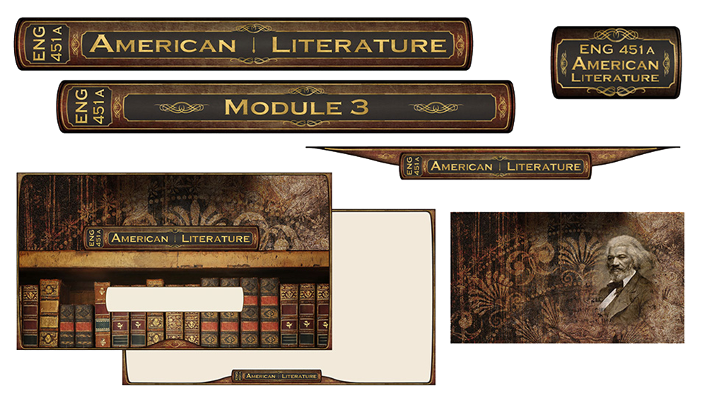Online courses are normally designed from an institutional template of common elements without reference to any particular subject matter. But this lack of context can get repetitive and boring. Faculty can instead design their courses with a theme that unifies the elements and pulls in the student. We have helped create a number of thematic courses and will discuss how to impart a theme to a course to increase interest and lower student anxiety in online courses.
What types of theming are there?
There are different approaches to theming a course: literal and metaphorical. The literal approach is to relate the theme to the subject of the course. For example, a literature course may use a classic book theme that presents imagery of period-appropriate literature and writing. The approach basically amplifies the subject of the course with imagery and elements that dress it up.

In the metaphorical approach, the theme that may or may not directly relate to the course subject. The course becomes a kind of journey that stimulates the student’s imagination to help transport them through the course content. For instance, the same English literature course mentioned above could be built around a mystical, Lord of the Rings–like voyage through a land where different stops represent the homes of various authors that students in the course will study.
What does our university do?
Our course development teams have produced exciting courses with themes such as virtual Vegas, high-end fashion, The Game of Life, Route 66, and the 1960s. Our goal is to take students on a learning journey that makes the online learning environment more inviting and less intimidating.
One example is GSC 100 (a first-year experience course), where the Route 66 theme takes students on a virtual road trip across the country—a metaphorical narrative for their journey through college. The course content presents students with the tools and strategies to complete their journey. We divide the virtual route from Los Angeles to Chicago into 15 individual stopovers or exits (one for each module in the course). Course banners, icons, and interactive learning objects all support the narrative. For example, each module includes an interactive presentation from which students learn about the module learning objects, and we have built an assessment to reinforce their learning of those subjects or objectives. Each module also includes podcasts and an audio player designed to look like a car stereo. When students complete the course, they achieve the final module, their last stop, and are armed with a career-ready plan for their new life journey.

A second example is CFA100, a first-year seminar where students learn about the different majors offered within the College of Fine Arts. We integrate the 1960s theme into all course content and include interactive virtual rooms—for example, a theater and architectural, art, recording, and dance studios—that represent each major within the college. Students explore each room to learn about aspects of each major while also learning about 1960s art and culture through materials such as ’60s-related timelines, articles, online resources, and videos.

Consistency is important for both the literal and metaphorical approaches. A useful strategy to implement visual consistency within a course is to create a style guide. It establishes guidelines specifying the consistent application of visual material throughout a course. Common examples include fonts, colors, banners, icons, and PowerPoint templates. These all work together to improve student experience.
How do you do it?
To create a course theme, the first step is to know yourself and your learners. Are the students STEM or fine arts majors? How do your personality, interests, and expertise relate to the course content? Then find a theme that aligns with the answers to these questions. If you are a mechanical engineer working on robotics teaching a seminar for engineering students, then perhaps a theme could include a robot character flying into space. If your course includes basic real-world applications, such as a general math course with concepts on finances and logic, perhaps a board game like The Game of Life would be an exciting theme for your course design.
Next, find others to work with in the ideation process. We take the approach that “teamwork makes the dream work.” Instructional designers usually love the opportunity to exercise creativity in coming up with course elements. Learn from each other’s insights, experiences, and expertise, valuing everyone’s input. If you find yourself the lone ranger of the department, then learn from colleagues both within and outside of your discipline. Collaboration is key to success in the ideation process.
Does it work?
Research indicates that developing courses using thematic course design can enhance the student experience. The literature and our own student surveys have shown us that students are more comfortable, have less anxiety, and relate to the content better if the course is designed around a theme. Research also shows that students will gain confidence in their ability to succeed in courses designed around a theme. In one research study, “students mentioned increases in motivation and enjoyment” (Tessier & Tessier, 2015).
Themes greatly enhance and add life to an online course. So, don’t hesitate to be creative in your course design!
Reference
Tessier, L., & Tessier, J. (2015). Theme-based courses foster student learning and promote comfort with learning new material. Journal for Learning through the Arts, 11(1). https://doi.org/10.21977/D911121722
Kristina Schmid is an instructional designer, Daniel Antoniuk is an instructional multimedia developer, and Amber Ford is an instructional design manager, all at the University of Nevada, Las Vegas.






